|
Phylum Annelida
|
|
- Segmented schizocoelous worms with a complete
digestive tract usually with regional specialization, a closed circulatory
system, a well developed nervous system with a ventral nerve cord and
segmental ganglia as well as a dorsal cerebrial ganglia, metanephridia,
paired segmentally arranged epidermal setae bundles, a head composed of a
presegmental prostomium and a peristomium, and usually with a trochophore
larva.
|
| |
|
Class Polychaeta |
|
sand worms, tube worms, clam worms, and others
(Figure 2). With numerous setae
(chaetae) on the trunk segments; most with well developed parapodia; prostomium
and peristomium usually bear sensory organs (palps, tentacles, cirri) or
extensive feeding and gas exchange tentacular structures; foregut often
modified as eversible stomodeal pharynx (proboscis), sometimes armed with
chitinous jaws; reproductive structures simple, often transient; without a
clitellum; most are gonochoristic; development often indirect, with a
free-swimming trochophore larva; mostly marine; burrowers, errant, tube-
dwelling, interstitial, or planktonic; some live in brackish water, a few
inhabit fresh water or are parasitic |
| |
|
Sister Taxa
Scolecida (Class Polychaeta) |
|
- Prostmial appendages absent
most burrowers or tube dwellers with a bulbous protrusable pharynx
|
| |
|
Family Arenicolidae(Sister Taxa Scolecida;Class Polychaeta) |
|
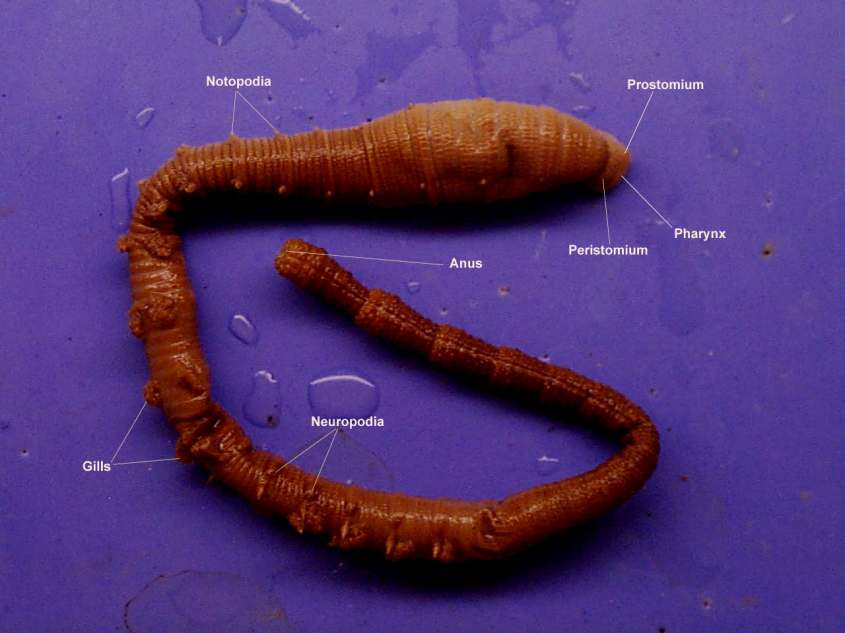
The so-called lugworms have a rather thick,
fleshy, heteronomous body divided into two or three distinguishable regions;
pharynx unarmed but eversible and aids burrowing and feeding; live
in intertidal and subtidal sands and muds in J-shaped burrows; direct deposit
feeders |
| |
|
Family Maldanidae(Sister Taxa Scolecida;
Class Polychaeta) |
|
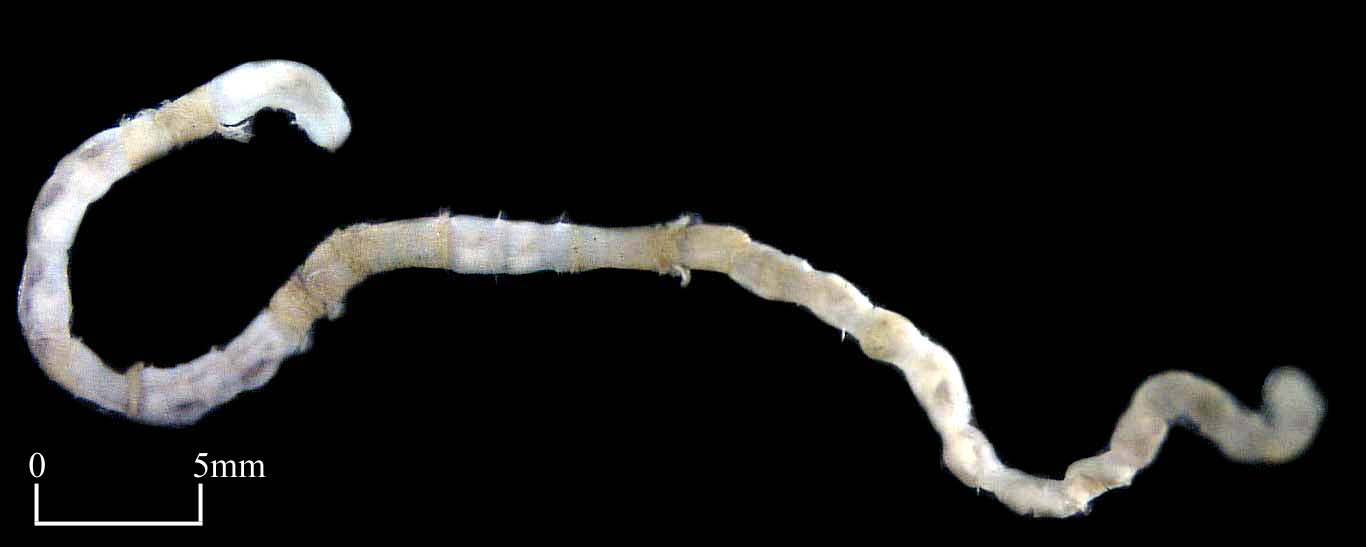
Body elongate and homonomous except that some
mid-trunk segments are elongate, hence the common name of "bamboo
worms"; burrow head downward and secrete a mucous sheath to which sand
particles adhere, thereby forming a tube; proboscis unarmed by eversible and
used in burrowing and selective deposit feeding. |
| |
|
Sister taxa Palpata
(Class Polychaeta) |
|
with a pair of sensory palps on the prostomium |
| |
|
Family Glyceridae (Sister taxa Palpata;
Class Polychaeta) |
|
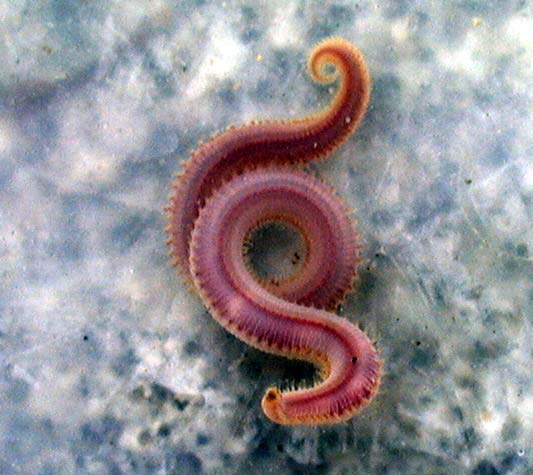
Long, cylindrical, tapered, homonomous body;
enormous pharynx armed with four hooked jaws used in prey capture; large
pharyngeal proboscis also used in burrowing; most are infaunal burrowers in
soft substrata |
| |
|
Family Nereidae(Sister taxa Palpata;Class Polychaeta) |
|
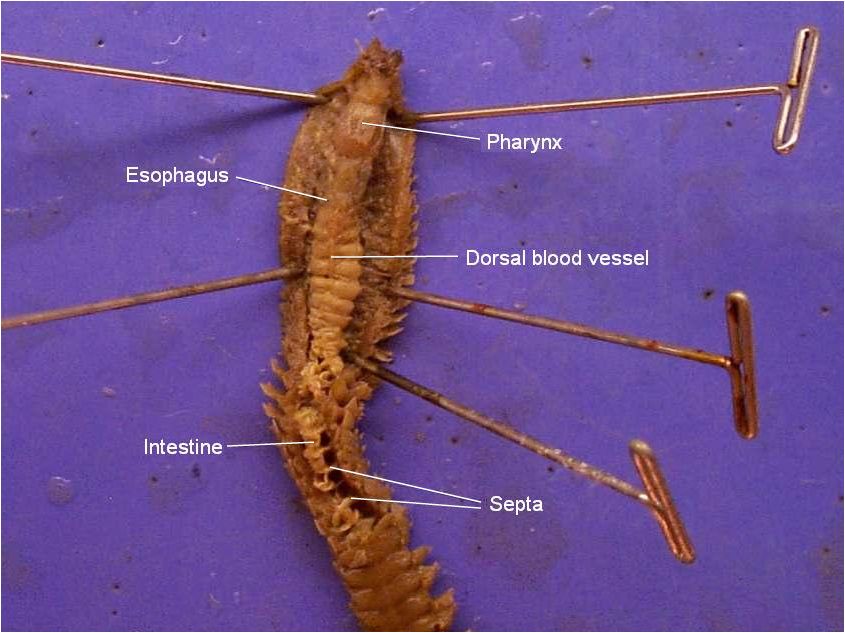
Moderate to large polychaetes tending to
homonomy; mostly errant predators with well developed parapodia; one pair of
large curved pharyngeal jaws; some burrow, but most are epibenthic in protected
habitats: among mussel communities, in
holdfasts of algae, crevices, under rocks, et. (Internal anatomy) |
| |
|
Family Nereidae(Sister taxa Palpata;Class Polychaeta) |
|
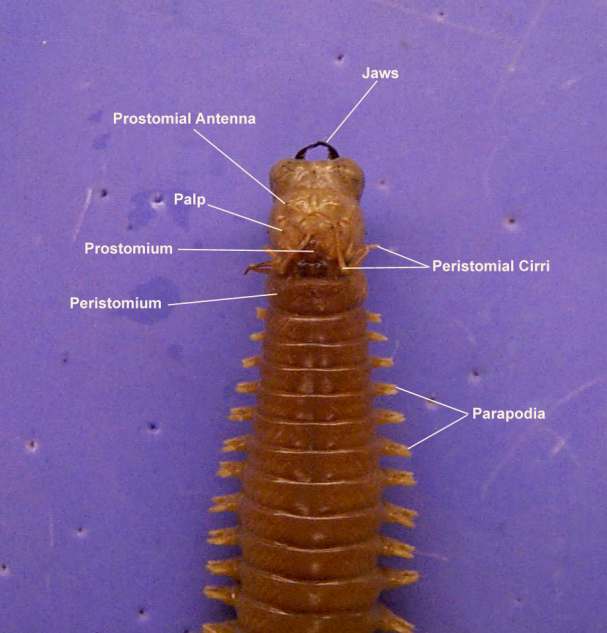
External Anatomy |
| |
|
Family Aphroditidae(Sister taxa Palpata;Class Polychaeta) |
|
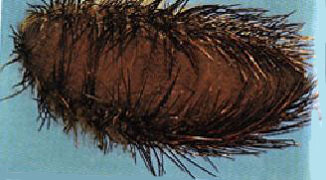
Body broad, oval or oblong, with less than 60
segments; with flattened, solelike ventral surface, and rounded dorsum covered
with scales (elytra) overlaid by a thick felt- or hairlike layer, giving some
the common name of "sea mouse"; slow moving, epibenthic or burrowers;
most are omnivorous |
| |
|
Sister Taxa Canalipalpata(Class Polychaeta) |
|
- Sedentary species in tubes
or burrows, groved palps used for deposit feeding.
|
| |
|
Family Chaetopteridae (Sister Taxa Canalipalpata;Class Polychaeta) |
|
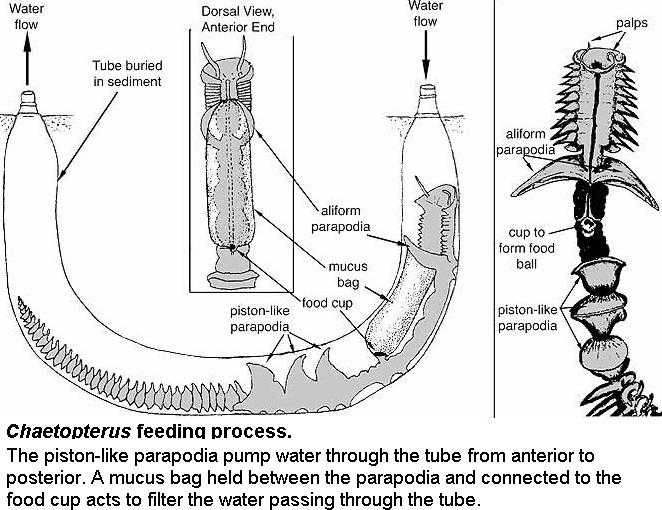
Body fleshy, relatively large and distinctly
heteronomous, divided into two or three functional regions with modified
parapodia; chaetopterids live in more-or- less permanent U-shaped burrows lined
with secretions from the worm, most are mucous-net filter feeders, eating
plankton and detritus passed through the tube by water currents |
| |
|
Family Terebellidae (Sister Taxa Canalipalpata;Class Polychaeta) |
|
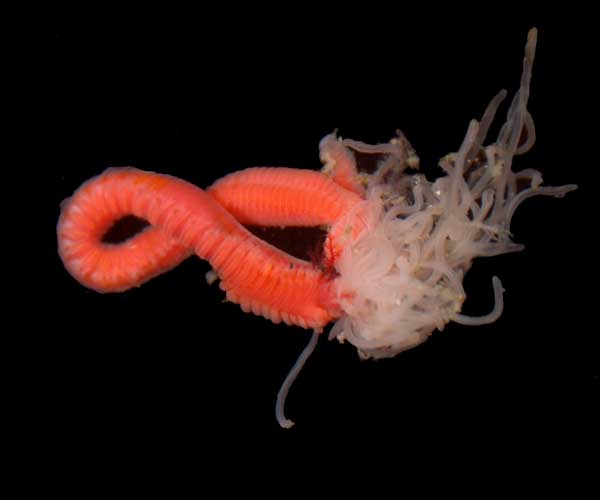
Moderate-sized tube-dwelling polychaetes with
fragile, fleshy bodies; heteronomous; body of two distinct regions; most lack
eversible pharynx; most live in various types of permanent tubes (e.g., mud,
sand, shell fragments); head bears numerous elongate feeding tentacles; most
with 1-3 pairs of well developed branchiae on anterior trunk segments; feed on
surface detritus |
| |
|
Family Sabellidae(
Order Sabellida; Sister Taxa Canalipalpata;Class Polychaeta) |
|
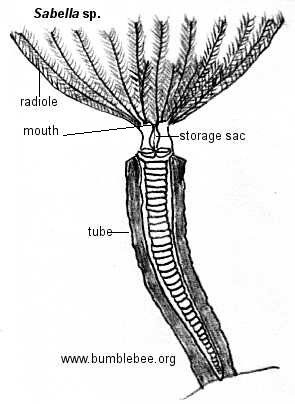
Tube-dwelling polychaetes commonly called
"fan worms" or "feather-duster worms"; body heteronomous,
divided into two regions similar to those of terebellids; pharynx unarmed and
noneversible; peristomium bears a classy crown of branched, feathery tentacles
that projects from the tube and functions in gas exchange and ciliary
suspension feeding. |
| |
|
Family Serpulidae(Order Sabellida; Sister Taxa Canalipalpata;Class Polychaeta) |
|
Heteronomous body divided into two regions; tube
dwellers; anterior end bears a tentacular crown as in sabellids, plus a
funnel-shaped operculum that can be pulled into the end of the calcareous tube
when the worm withdraws; ciliary suspension feeders. |
| |
|
Family Spirorbidae(Order Sabellida; Sister Taxa Canalipalpata;Class Polychaeta) |
|
Small heteronomous polychaetes living in coiled
calcareous tubes attached to hard substrata; tubes coil to the right or left,
usually depending on species; anterior end with tentacular crown and operculum
similar to those of serpulids. |
| |
|
Clitellata |
|
Annelids with a clitellum associated with
reproduction. No parapodia |
| |
|
Class Oligochaeta |
|
Earthworms and many freshwater worms (Figure
3). With few setae and no parapodia;
cephalic sensory structures reduced; body externally homonomous except for
clitellum; often with complex reproductive systems; hermaphroditic; often
placed as a subclass of the class Clitellata; fresh water, terrestrial, some
marine. This class comprises three
orders based in part on details of the male reproductive system, the first two
contain a single family each. There is
some controversy about the taxonomic arrangement of oligochaetes. |
| |
|
Order Lumbriculida(Class Oligochaeta) |
|
Moderate-
size, freshwater oligochaetes, many of which are known only from Lake Baikal in
the Soviet Union. |
| |
|
Class Hirudiniomorpha |
|
Leeches
(Figure 4). Body with fixed number of
segments, each with superficial annuli; heteronomous, with clitellum and a
posterior and usually anterior sucker; often placed as a subclass of the class
Clitellata; complex reproductive systems, hermaphroditic; most are fresh water
or marine, a few are semiterrestrial; ectoparasitic, predaceous or scavenging |
| |
|
Oligocheata(Internal anatomy) |
|
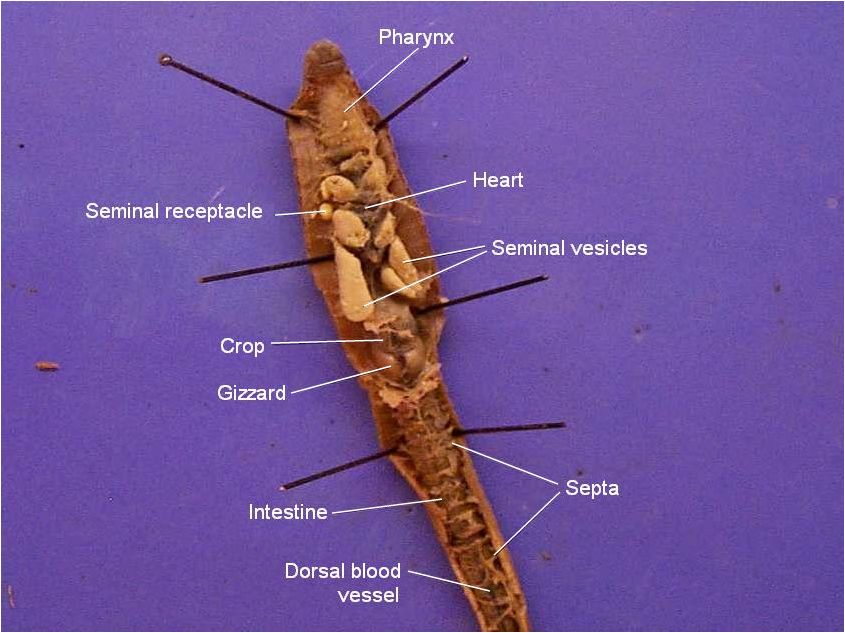
1)
The longitudinal muscles are divided into seven
bands; a dorsolateral pair, two pairs of ventrolaterals, and a single
midventral muscle
2)Setae held in place by retractor muscle(specialized oblique muscles)
3)
ventral nerve cord, and the excretory and
reproduction organs and envelops the gut(identify)
4) typhlosole: Increases surface area in gut
|
| |
|
Oligocheata(Internal anatomy) |
|
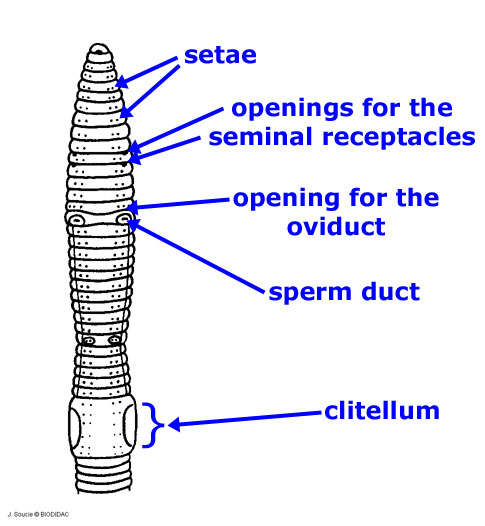
1)Periostomium: well marked external segment of the body that surrounds the mouth
2)Setae (8 on each segment) point towards posterior
3) Coloration is lighter on ventral side and can see vein similar to that of Dugesia
4) Clitellum: Secretes cacoon around eggs( not annulated or grooved)
|
| |
|
Polycheata (external anatomy) |
|
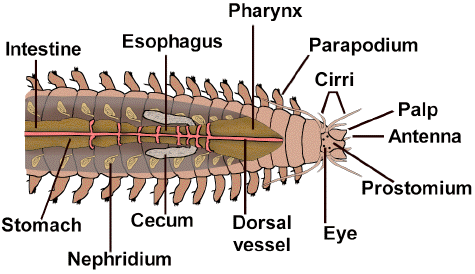
1) difference from Oligocheata is the presence of lateral segmented projections.(Swimming and Crawling)
2)
papapodium is biramous, consisting of a bilobed
dorsal notopodium and ventral neuropodium, which function in respiration and
locomotion.(From each arises
a tactile cirrus and a bundle of jointed
chitinous setae)
3)papapodium supported by 2 setae known as
acicula
4) Many Setae
5) 4 prostomial eyes
6)
pair of prostomial tentacles and paired palps
7)
eversible pharynx with its black serrated teeth
or denticles |
| |
|
Hirudinea (External Anatomy) |
|
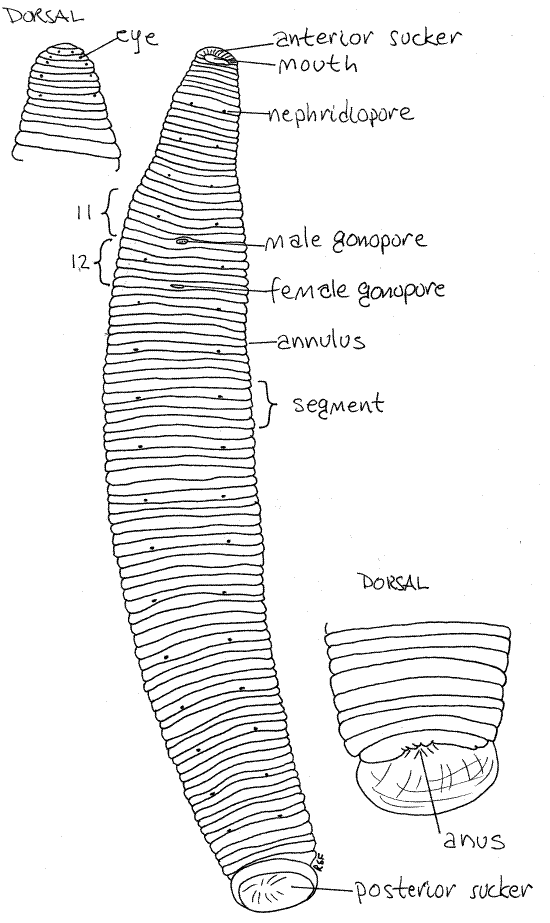
1)25 segments
2) 2 annuli per segment
3)
ventral sucker(more pointy end)
4)
posterior end bears a large disklike ventral
sucker
|
| |
|
Differences in External anatomy between the 3 classes |
|
1)Oligocheata has no eyes because it is a dirt eatter so doesnt need to prey on food
2)Oligocheata setae are used more for digging while the other two use them for swimming and crawling
3) Oligocheata dont have parapodia beacuse they would get in the way of digging
4) Polycheata most specialized segment is cephilized while earthworms it is the clitellum
|
| |
|
Polycheata (internal anatomy) |
|
1) Oblique muscles are used to move parapodia |
| |
